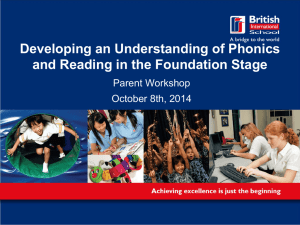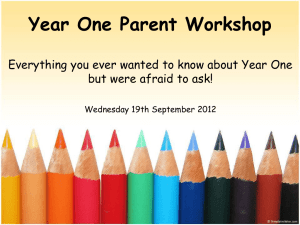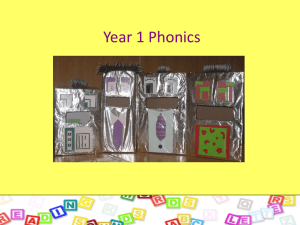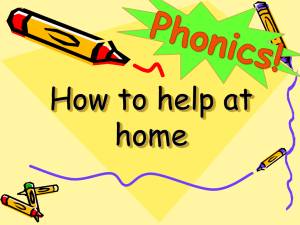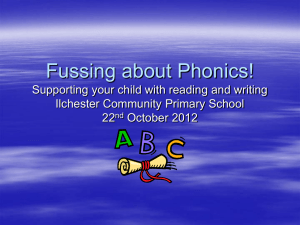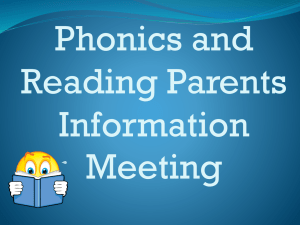Phonics-Screen-Test-2014 - Middleton Parish CE Primary School
advertisement
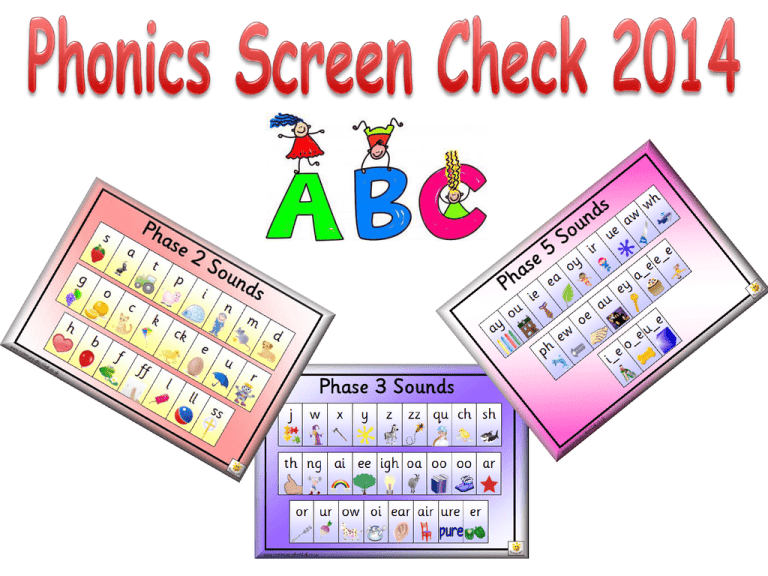
• • • • • • • What is phonics? What is the phonics screening test? What will the test comprise of? Example words How will the test be administered? What will happen after the test? How you can help at home. • Way of teaching children to read skillfully. • Children are taught how to recognise phonemes (sounds) that each individual letter makes and identify the sounds that different combinations of letters (graphemes) make eg. ‘oo’, ‘sh’, ‘air’ etc. • Digraph - 2 letters that make 1 sound cow • Trigraph - 3 letters that make 1 sound night • Split digraph - 2 vowels with a consonant in between. Used to be known as the magic e! spine (i_e) • They are then taught how to blend these phonemes together to read the whole word. • Children can then use their phonic knowledge to ‘de- code’ unfamiliar words. • In school children have 20 minutes of daily discreet phonics teaching following the Government’s Letters and Sounds programme. • A statutory reading check that every Year 1 child in the country will complete in the same week. • It will take place in school during the week beginning 16th June. The check cannot be retaken at any other time so it is essential that your child is in school this week. • The focus of the check is to provide evidence of children’s decoding and blending skills, not to test their vocabulary. • The check will consist of reading 40 words and non-words (pseudo words) • The children will be asked to ‘sound out’ a word and blend the sounds together. e.g. s-t-ar-t • Children will be told if the word is a real or ‘alien’ (pseudo) word. The pseudo word will be put into context by having a corresponding alien image. The children will be asked to read the alien’s name. • The children MUST sound out the correct phonemes and blend together whichever graphemes form that particular word. day snemp slideslide blurst newt spron phone stroft • With your child’s own teacher. • In a quiet area of the school. • We are not permitted to indicate to the children at the time whether they have correctly sounded out and/or blended the word. • There is no time limit and the test is designed not to be stressful for the children. • High standard pass threshold of 32 out of 40 • Last year the national pass rate was 69% • Anticipate good pass rate this year and have implemented practise tests and additional intervention groups to support children. • Revise the Phase 2, 3 & 5 graphemes at home with your child using the Phonics sound mats. • Practice reading the sample real and pseudo words with your child, encouraging them to ‘sound out’ the word and blend it together. • Help your child to use their phonic knowledge to ‘make up’ pseudo words using single letters, digraphs and trigraphs. • Use online games on www.phonicsplay.co.uk to read real and pseudo words. • REMEMBER: Phonics is not the only thing needed to become a fluent reader. • Please continue to read with your child each night and encourage them to: • Sound out • Re-read to check it makes sense. • Use pictures for clues. • Ask questions about the book. • And most importantly ENJOY READING! • The results of each check will be sent to the Local Authority. Each Local Authority will then submit the results to the Department for Education. • We will inform you of whether your child has met the national standard. • Children’s reading develops at different rates and if your child’s scores fails to achieve the national standard, further support will be implemented this year and going into Year 2. • Re-takes of the screening test for these children will take place in Year 2.
